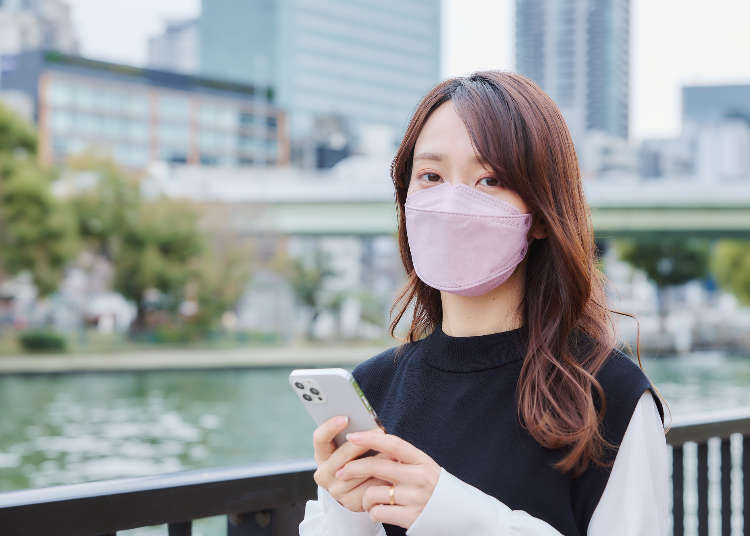
Are Masks Required in Japan? Manners & Travel Etiquette for Foreign Visitors to Keep in Mind
- Written by: Miyu Shimada
After a long period of strict immigration restrictions due to the COVID-19 pandemic, the restrictions were significantly relaxed on October 11, 2022, and foreign tourists are beginning to return to the lively atmosphere before the pandemic. Furthermore, as of March 13, 2023, it has been left up to individuals to decide whether or not to wear masks in Japan.
This article introduces information on Japan's current COVID-19 measures, manners, and etiquette. We will explain the necessary information for enjoying travel with peace of mind in the new way of life.
main image: PIXTA
- Table of Contents
-
- What is the situation in Japan for accepting foreign tourists?
- Do tourists have to do anything special when preparing for a trip to Japan?
- What does "New Travel Etiquette for Visitors" actually entail?
- Are masks required in Japan?
- Where can I buy a mask while traveling?
- Follow health & safety measures and enjoy an unforgettable trip through Japan!
What is the situation in Japan for accepting foreign tourists?
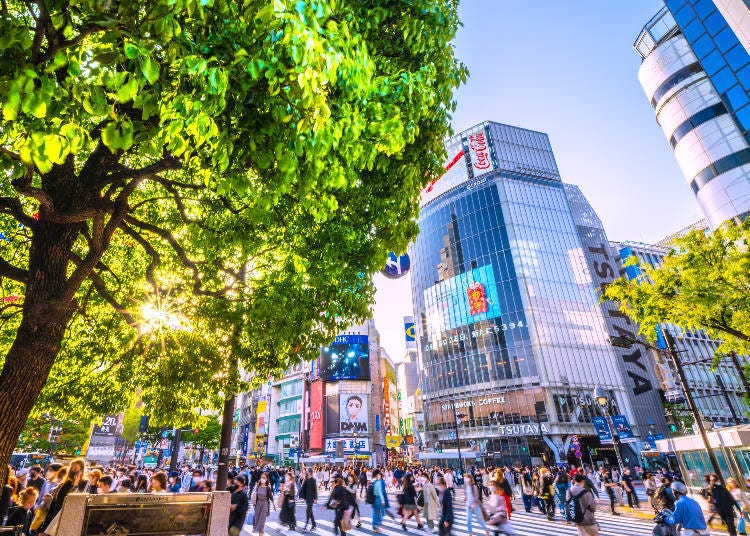
Regarding the COVID-19 infection situation in Japan, as of October 11, 2022, at 12:00 AM (Japan time), Japan's border control measures have been significantly relaxed, which has resulted in a major advancement in the acceptance of foreign visitors and the easing of entry restrictions.
The changes related to foreign tourists visiting Japan include the following mainly:
・Removal of the upper limit on the number of entries
・New entry for short-term stays for tourism purposes and long-term stays are possible
・Individual foreign tourists are allowed to enter (previously only limited to package tours)
・Lifting of visa-free travel for short-term stays
・No requirement for a COVID-19 test upon entry. However, it is necessary to submit proof of vaccination (three doses) for vaccines listed on the World Health Organization's (WHO) Emergency Use List or a negative test result certificate taken within 72 hours before departure.
Do tourists have to do anything special when preparing for a trip to Japan?
In June 2022, with the acceptance of foreign tourists, guidelines for "Guidelines for Accepting Foreign Tourists" were established for travel agencies. These guidelines are intended to provide a policy for businesses that accept tourists to thoroughly implement infection prevention measures. As individual measures for preventing infection, caution is being raised through leaflets, posters, and other materials as follows.
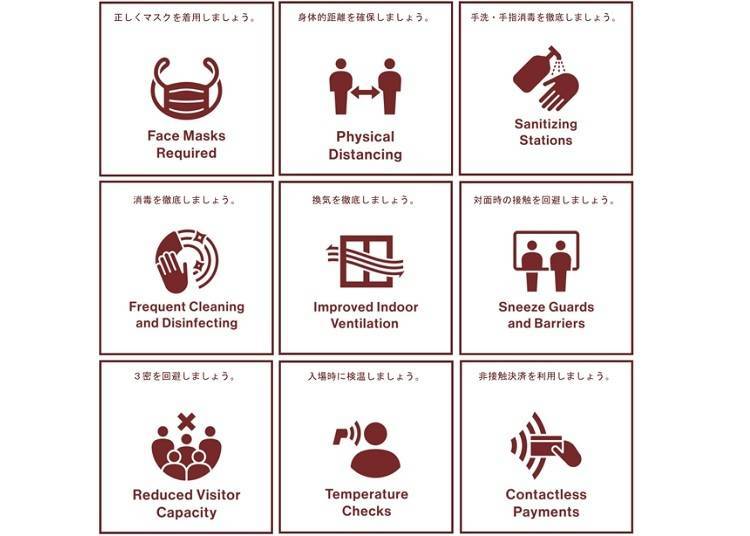
On the other hand, the Japan Tourism Agency and the Ministry of Health, Labour and Welfare have released information for travelers to pay attention to from the traveler's perspective of traveling safely in Japan, such as "New Travel Etiquette" and "Wearing Masks Indoors and Outdoors."
*From March 13th, wearing masks will be left up to individual discretion.
What does "New Travel Etiquette for Visitors" actually entail?
The "New Travel Etiquette for Visitors" is a guide for travelers to travel safely while avoiding the risk of contracting Covid. It focuses on specific precautions outlined for each aspect of traveling (movement, meals, accommodations, tourist facilities, shopping).
The first edition was published in September 2020, followed by a revised edition in December 2021, with more concise rules for each travel scene and facility.
With Japan's travel ban lifted, it is important for visitors to observe these new points of travel etiquette while sightseeing.
Here are some excerpts from the "New Travel Etiquette for Visitors." Explanatory text for each item has been added by the LIVE JAPAN editorial staff.
Etiquette for Various Occasions and Facilities
1. General Version
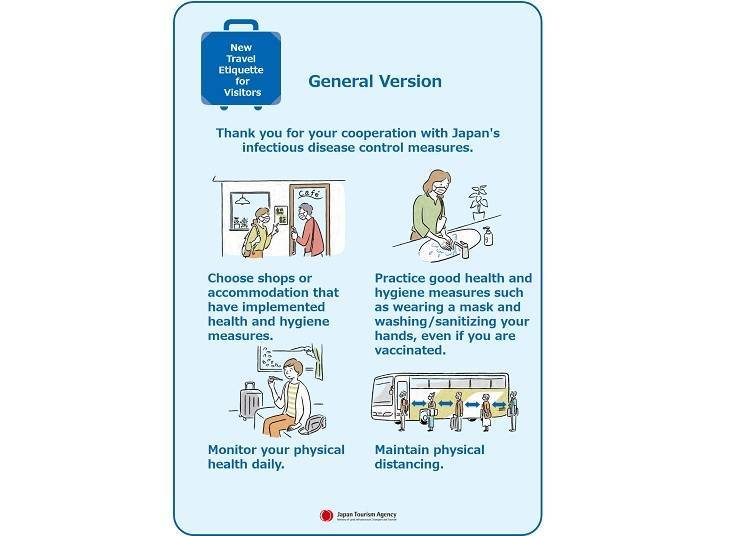
Though most shops in Japan have Covid-19 countermeasures in place, it’s important to choose facilities that ask their customers to engage in health and hygiene measures as well. Even if you’re vaccinated, it’s requested that masks are worn, and hands are washed/sanitized. Travelers must also monitor their physical health daily and maintain physical distancing.
LIVE JAPAN Tips
・While hand dryers are now available in bathrooms in some facilities, there are still many places where they are not. Be sure to bring a handkerchief or towel.
・In addition, most facilities have hand sanitizer and a thermal camera at entrances and exits, so be sure to use them.
・Hand sanitizer (sheets, sprays, etc.) is also readily available at convenience stores and pharmacies.
2. Accommodation
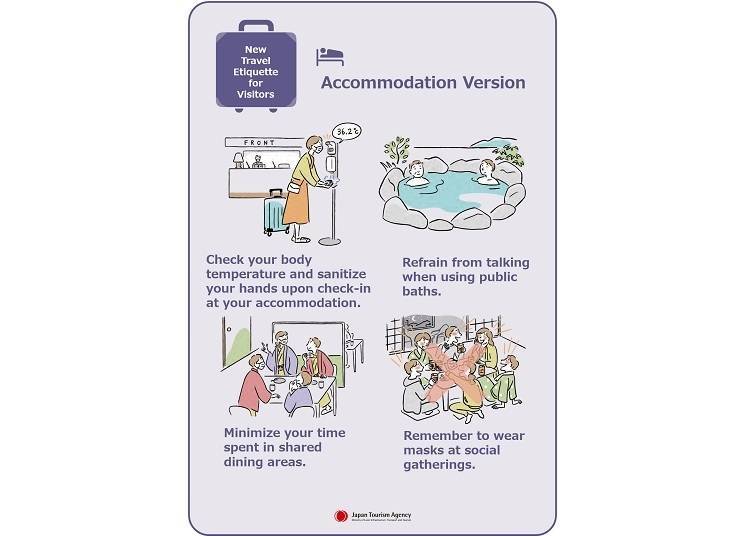
When checking in, don’t forget to check your body temperature and sanitize your hands. Also, it’s advised to limit conversation in your accommodation’s common areas and minimize time spent in shared dining spaces. If you’ve booked a stay as a group, it's advised to wear a mask even in the guest rooms.
Also, since masks tend not to be allowed in hot springs baths, when partaking of this Japanese custom, it's recommended to enjoy "silent bathing."
LIVE JAPAN Tips
・Recently, there has been a rise in accommodations offering automated check-ins.
・Meal times at many facilities is staggered to avoid congestion. Particularly when checking in at a ryokan inn, the staff may ask you when you would like your dinner/breakfast.
・Some facilities also offer an in-room meal option.
・It is an unspoken rule to wear a mask when moving to the dining room or restaurant, and to eat while talking as little as possible during meals.
・Each facility may have its own rules, such as using disposable gloves (provided) when choosing items from a buffet. Be sure to ask staff if you have any questions.
3. Transportation
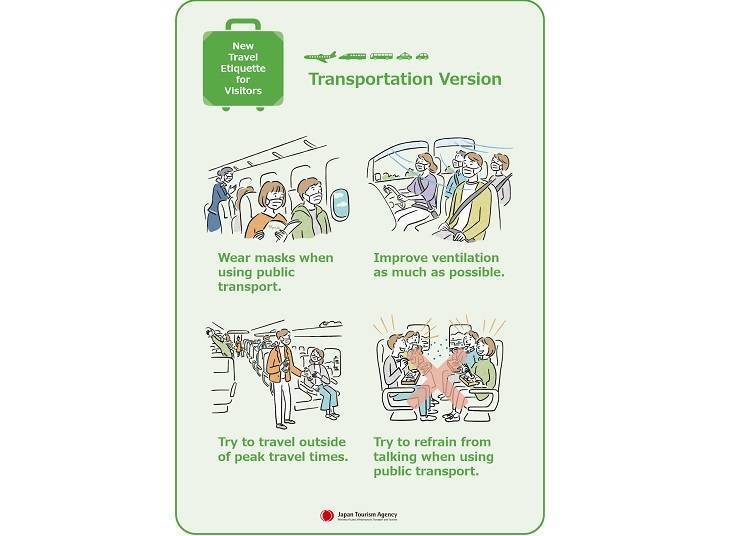
Special care should be taken when using public transportation such as trains, buses, airplanes, and cabs. It is recommended that you wear a mask when using public transportation. It is also advisable to avoid talking with friends and family members in the car or on the plane, and to use an empty car or seat if you have a choice.
LIVE JAPAN Tips
・In Japan today, the wearing of masks on public transportation is not "mandatory" but rather "requested" or "recommended."
・To avoid unnecessary trouble, you may wish to wear a mask on public transit and speak sparingly (and in a quieter voice when you do).
・Also, alcohol sanitizer is often not available on public transit (especially trains), so it is a good idea to have your own.
4. Sightseeing and Shopping
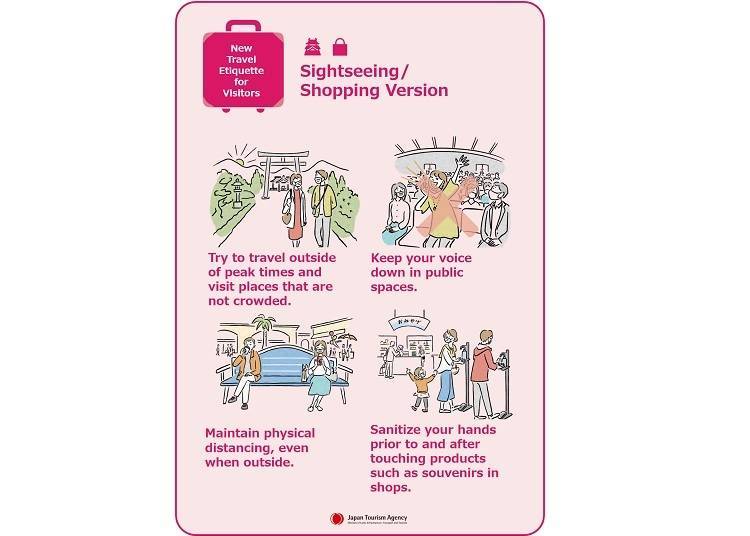
Peak times should be avoided as much as possible when sightseeing or shopping. Although it’s easy to get swept up in the fun of visiting tourist attractions, it’s asked that they are enjoyed quietly. Even when lining up outside, there should be some physical distance maintained. When it comes to souvenirs out in the open for anyone to touch, hands should be sanitized before and after.
LIVE JAPAN Tips
・Recently, many convenience stores and supermarkets have introduced self-checkout systems, many of which accept credit cards as well as cash.
・Transportation IC cards such as Suica and PASMO can be used not only for transportation but also for shopping.
・Prior to Covid, Japan was a very cash-oriented society. Now, there are many places that only accept cashless payment. Having some cash on hand (e.g. 10,000 yen) is still recommended, you may be able to get by much easier with your credit card or a PASMO/Suica card.
・Many facilities and stores have sanitizer at their entrances for your peace of mind.
・To ease congestion, many spots have introduced reservation systems. You may need to register ahead of time for a specific time slot - particularly for popular cafes, restaurants, and attractions. If there is a spot you want to visit, please check the official website for the latest information before your visit.
5. Drinking/Dining
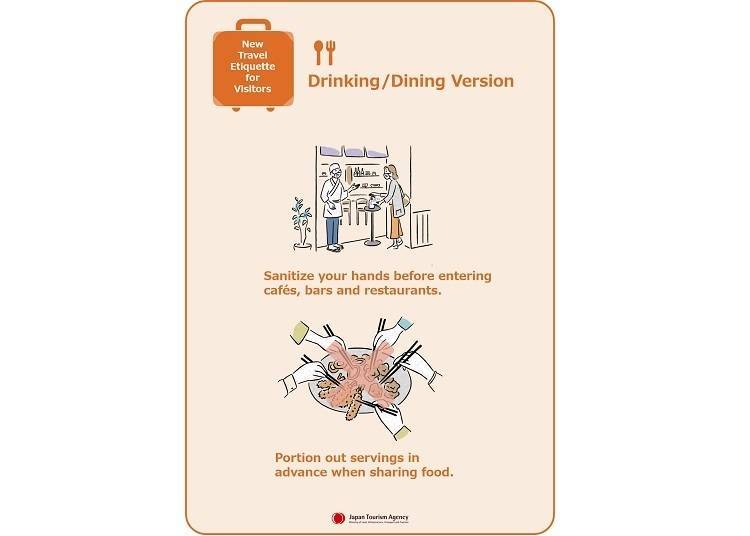
At cafes, bars, or restaurants, it’s important to sanitize your hands before entering facilities, as well as portioning out servings in advance when sharing food. Also, as food and drink can spray very easily, practicing “silent eating” is recommended even if you are dining with other people.
When having drinks, it can be easy to get distracted and forget to take various precautions, but Covid etiquette should also be observed before clinking glasses.
LIVE JAPAN Tips
・Recently, restaurants are returning to their pre-Covid bustle.
・More and more restaurants are introducing contactless services such as mobile ordering, payment, and serving robots, which are becoming safer and more convenient to use.
・However, basic infection control measures such as sanitizing hands and temperature checks are being taken more thoroughly than anywhere else, so it is a good idea to wear a mask at all times except when you are eating.
Are masks required in Japan?
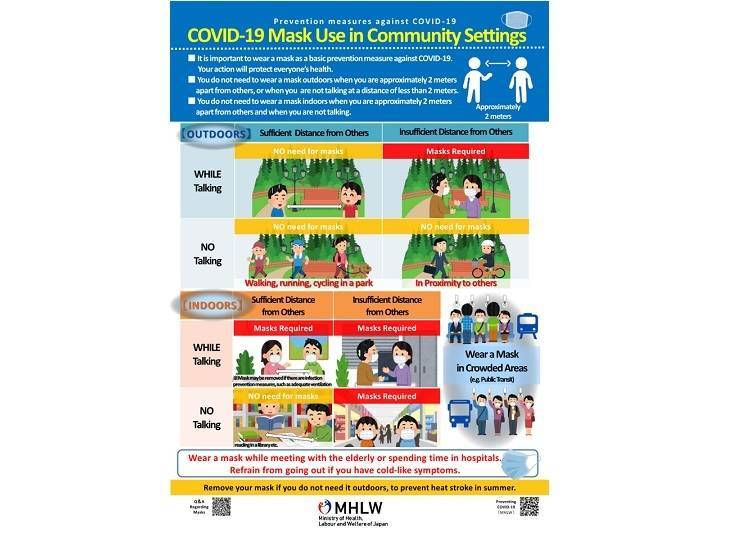
In February of this year, the Ministry of Health, Labour and Welfare in Japan announced its stance on mask-wearing and starting from March 13th, it respects individual choice and leaves the decision to wear a mask up to the person.
However, it still recommends wearing masks in certain situations, such as when visiting medical institutions, hospitals or elderly care facilities, during rush hour on crowded trains or buses, and when visiting crowded places during the pandemic period, especially for people with a high risk of severe illness.
The ministry released guidelines for mask-wearing indoors and outdoors until March 12th, emphasizing the importance of wearing masks as a basic measure to prevent infection.
Please check the official website of the Ministry of Health, Labour and Welfare for more detailed information and updates.
Outdoors

If you are outdoors and able to maintain a sufficient distance from others, there is no need to wear a mask even if you are having a conversation. Similarly, if you are engaging in activities such as walking or running without having close contact with others, wearing a mask is not necessary. However, if you are having a conversation with someone while being in close proximity, wearing a mask is recommended.
Indoors
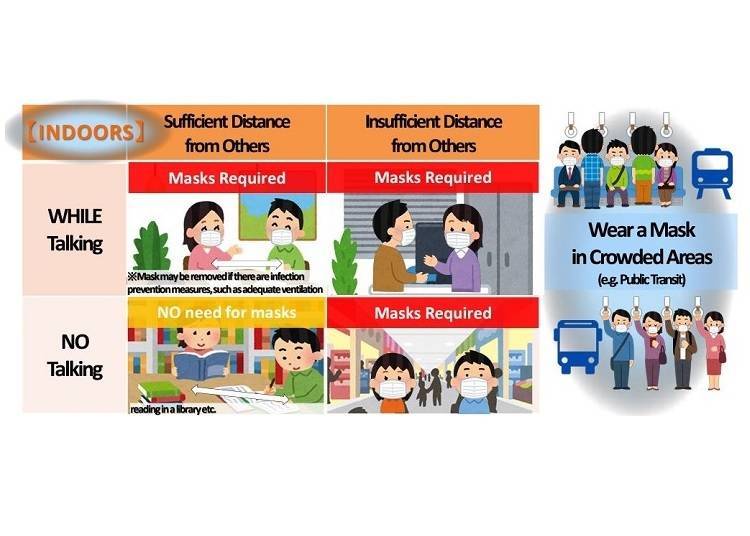
When indoors, if there is enough distance between people and no conversation is taking place, wearing a mask is not necessary. However, if there is a conversation, regardless of the distance between people, wearing a mask is recommended. Also, even if there is no conversation, wearing a mask is recommended when people are in close proximity, in crowded places such as public transportation or workplaces.
However, as of October 2022, many restaurants and facilities in Japan are effectively requesting that masks be worn, and there are some places where entry or admission is denied if masks are not worn. Since a high percentage of people in Japan voluntarily wear masks at the individual level, it is reassuring to have the understanding that "wearing a mask indoors" is recommended.
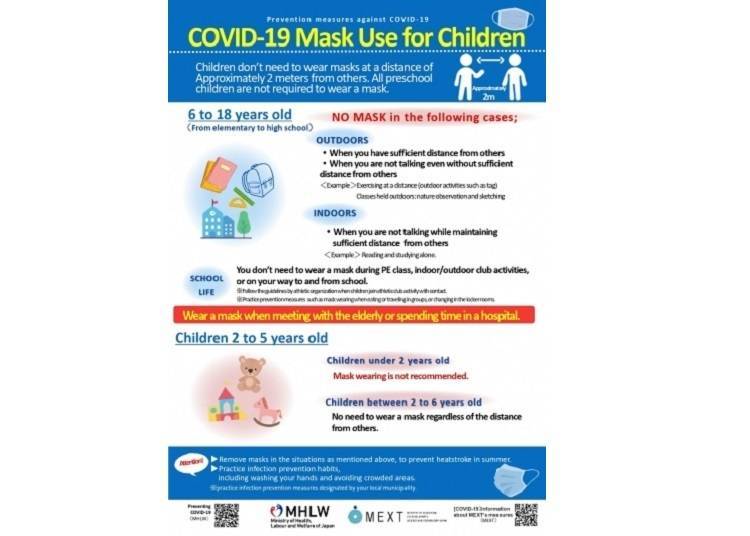
Separately, guidelines have been established for children. In principle, wearing masks is not recommended for children under 2 years of age. For children aged 2-6 years, masks are not necessary, regardless of their proximity to others.
For children aged 6-18 years, similar to adults, masks are not necessary outdoors if they are able to maintain a sufficient distance from others, even if they are close but not engaging in conversation. Additionally, if they are indoors and able to maintain a sufficient distance from others without engaging in conversation, masks are not necessary.
Where can I buy a mask while traveling?
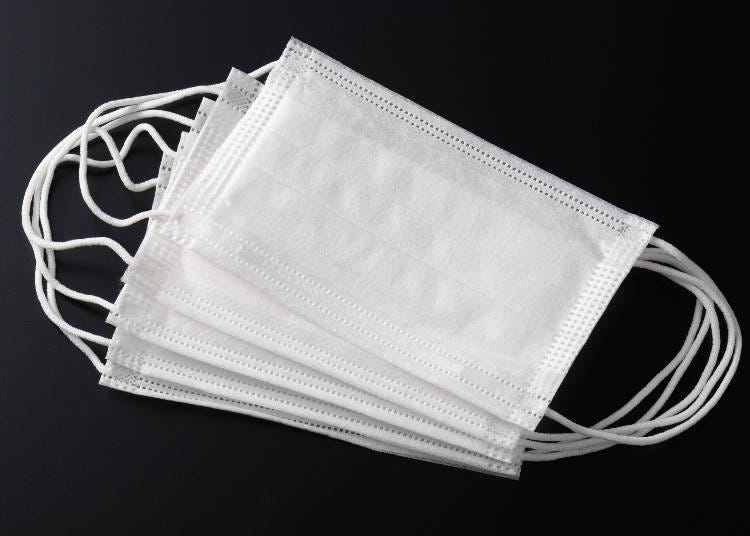
In Japan, it is relatively easy to purchase masks anywhere. Disposable masks are sold at airport and train station kiosks, most convenience stores, pharmacies, and supermarkets. Many also carry hand sanitizer. Cloth masks that can be washed and used repeatedly can also be purchased at apparel and general merchandise stores.
Follow health & safety measures and enjoy an unforgettable trip through Japan!
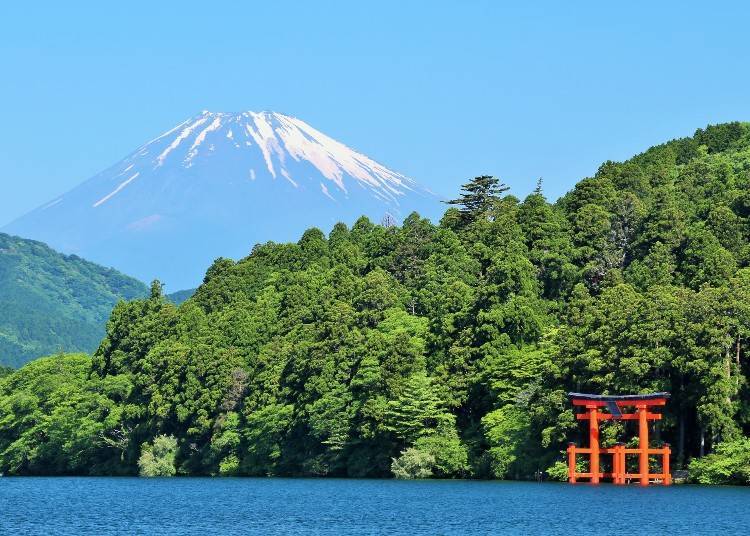
These guidelines for infection control measures set by the government are not mandatory rules that you will be punished if you do not follow. However, many people in Japan tend to voluntarily take infection control measures, including wearing masks, and you may feel obligated to do so in some situations.
Obeying the rules according to the new travel style, even if a little cramped, is an important part of having a safe and enjoyable trip in Japan. It is not only to protect ourselves, but also to protect the tourist attractions and tourist businesses.
Additional information from the government can be found below to help make your trip to Japan the most memorable experience possible.
*The information in this article was originally published in June 2020 and updated in March 2023. Please check the official website of each institution for the latest information.
Miyu is a travel writer and tour conductor with over a decade of experience in developing educational content for working individuals. She has a passion for exploring new cultures and has visited more than 150 cities in around 50 countries. Her goal is to sample great food, experience nature, enjoy historical sites, and bathe in hot springs around the world. Miyu left her corporate job to pursue her passion for travel and now spends over 100 days a year abroad while working as a writer. She promotes the joy of travel, the beauty of Japan, and the diverse cultures of the world by traveling to different parts of Japan and collaborating with inbound tour operators and fellow travel writers.
*Prices and options mentioned are subject to change.
*Unless stated otherwise, all prices include tax.
Popular Tours & Activitiess
Recommended places for you
-

Kanzenkoshitsuyakinikutabehodai Gyugyu Paradise Sannomiya
Yakiniku
Kobe, Sannomiya, Kitano
-

ISHIDAYA Hanare
Yakiniku
Kobe, Sannomiya, Kitano
-

Jukuseiniku-to Namamottsuarera Nikubaru Italian Nikutaria Sannomiya
Izakaya
Kobe, Sannomiya, Kitano
-
Appealing

Rukku and Uohei
Izakaya
Sapporo / Chitose
-
Goods

Yoshida Gennojo-Roho Kyoto Buddhist Altars
Gift Shops
Nijo Castle, Kyoto Imperial Palace
-

Kambei Sannomiyahonten
Yakiniku
Kobe, Sannomiya, Kitano
-

[Extended Offer!](12% OFF KKday Coupon) Mt. Fuji Autumn Leaves, Powder Snow & More! 15 Best Tours to Experience Japan in Fall & Winter
-

Keisei × Keikyu 16-Temple Goshuin Tour: Discover Deeper Tokyo & Yokohama
by: Guest Contributor
-

A Travel Game Changer! Go Hands-Free Between Tokyo and Kyoto with LUGGAGE EXPRESS by JTB and JR Tokai
by: Guest Contributor
-

Get Ready to Catch 'Em All! First Ever Permanent Outdoor Pokémon Park Opening Near Tokyo!
-

Tokyo City Pass Upgrade: Harry Potter Studio Tour & Top Sights up to 85% Off
by: Guest Contributor
-

The Best Japanese Food Representing 2025! 'Dish of the Year®' Annual Award Results Announced
-

Sapporo New Chitose Airport (CTS): Complete Guide to Restaurants, Souvenirs, Shopping & More!
-

(Video) Walking Tour along Narita Omotesando - Quaint Historical Village near Narita Airport!
by: Victor Gonzalez
-

Iwate Bucket List: 20 Best Things to Do in Iwate Prefecture For Tourists (Attractions, Food, Activities)
-

Top 6 Ramen Shops in Odori: The Birthplace of Sapporo Ramen
-

'Is This Some Kind of Rally?!' 5 Things About Tokyo City that Shock People from the Countryside!
-

This is the way to get around in Tokyo Station at the first time!
- #best sushi japan
- #what to do in odaiba
- #what to bring to japan
- #new years in tokyo
- #best ramen japan
- #what to buy in ameyoko
- #japanese nail trends
- #things to do japan
- #onsen tattoo friendly tokyo
- #daiso
- #best coffee japan
- #best japanese soft drinks
- #best yakiniku japan
- #japanese fashion culture
- #japanese convenience store snacks













